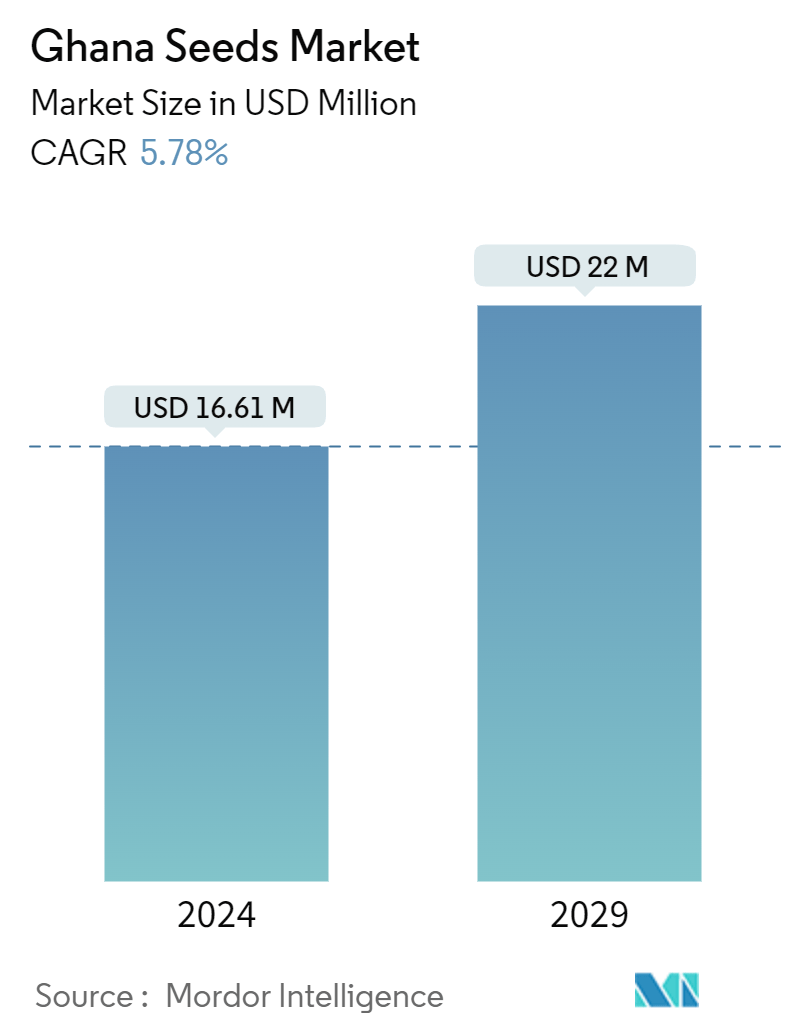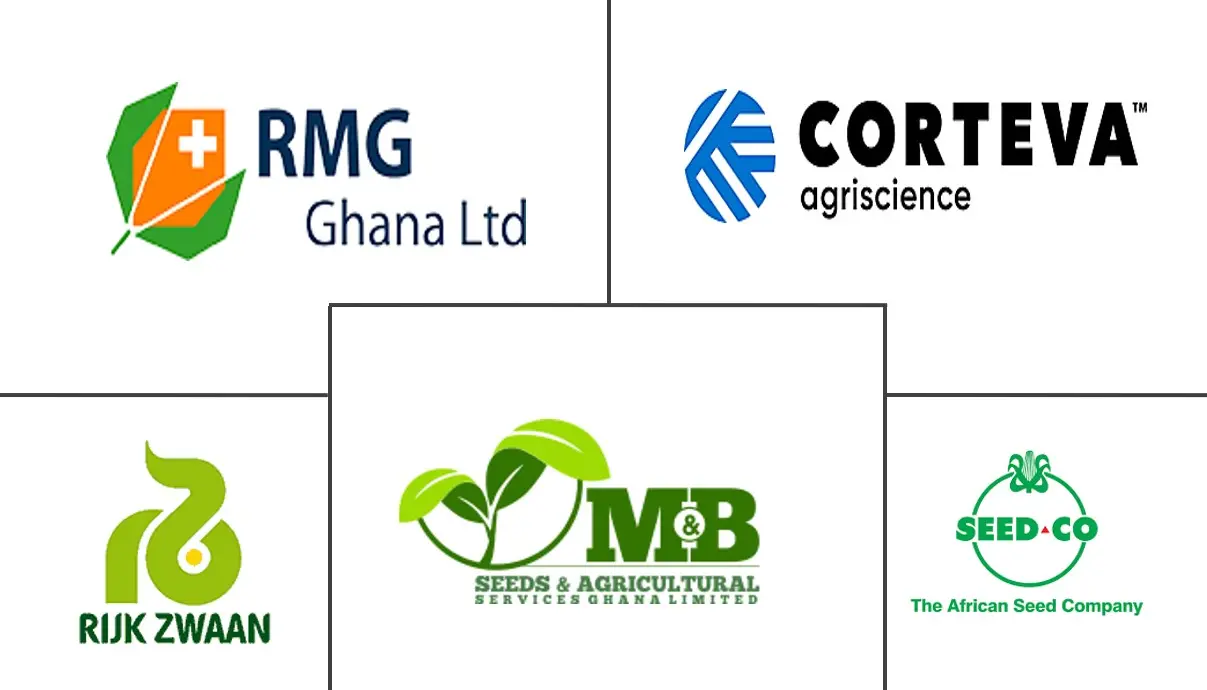Market Size of Ghana Seeds Industry

| Study Period | 2019 - 2029 |
| Base Year For Estimation | 2023 |
| Market Size (2024) | USD 16.61 Million |
| Market Size (2029) | USD 22 Million |
| CAGR (2024 - 2029) | 5.78 % |
| Market Concentration | Low |
Major Players
*Disclaimer: Major Players sorted in no particular order |
Ghana Seeds Market Analysis
The Ghana Seeds Market size is estimated at USD 16.61 million in 2024, and is expected to reach USD 22 million by 2029, at a CAGR of 5.78% during the forecast period (2024-2029).
- Ghana's seed market has experienced significant growth over the past decade. Despite the development and availability of improved and locally adapted seed varieties, the adoption rate remains marginal. According to the National Seed Trade Association Ghana (NASTAG), only about 35-40% of farmers were using improved varieties as of 2023.
- Ghana faces challenges due to population growth and land degradation, leading to an anticipated decrease in per capita land availability. For example, cassava, a major crop in Ghana's farming systems, has seen a reduction in cultivation area from 10.6 million hectares in 2020 to less than 10.4 million hectares in 2023, as reported by the Food and Agriculture Organization of the United Nations. This decreasing per capita availability of arable land is a significant concern for Ghana's agricultural production. However, it also serves as a driver for the seed industry. The need to increase production from diminishing arable land to achieve higher returns can be addressed using high-yielding and hybrid varieties. This trend is encouraging farmers to shift from conventional seed sources to packaged seeds that offer better yields.
- The demand for seeds across Ghana remains largely untapped, presenting various opportunities for multinational corporations to expand and reach a broad customer base. In 2023, the East-West Seed Foundation initiated a project called "Transforming Vegetable Farming as a Business" in Ghana. This one-year project aims to empower 11,880 farmers in the Bono, Bono East, and Ahafo regions by teaching them to grow and market vegetables profitably using superior seeds and sustainable farming practices. The initiative seeks to develop a competitive agro-input market, particularly in seeds. Additionally, the growing interest in vegetable cultivation in the country, driven by changing dietary preferences and increased cash flows for farmers, is further propelling the growth of the seed market in Ghana.
- Several players are taking initiatives to boost the growth of the seed market. For instance, the "1 Household, 1 Garden" initiative run by Agrihouse Foundation in Ghana is motivating and supporting the people of Ghana to contribute to the growth of the seed market.
Ghana Seeds Industry Segmentation
A seed is the ripened fertilized ovule of a flowering plant containing an embryo and is capable of germination to produce a new plant. The Ghana Seeds Market is Segmented by Type (Non-GM/Hybrid Seeds, GM Seeds, and Open-pollinated Varieties) and Crop Type (Grains and Cereals, Pulses and Oilseeds, Fruits and Vegetables, and Other Crop Types). The report offers market size and forecast in terms of value (USD) and volume (Metric Tons) for the above segments.
| Type | |
| Non-GM/Hybrid Seeds | |
| GM Seeds | |
| Open-pollinated Varieties |
| Crop Type | |
| Grains and Cereals | |
| Pulses and Oilseeds | |
| Fruits and Vegetables | |
| Other Crop Types |
Ghana Seeds Market Size Summary
The Ghana seed market is experiencing notable growth, driven by the need to enhance agricultural productivity amid decreasing per capita arable land. The adoption of high-yielding and hybrid seed varieties is becoming increasingly important as farmers shift from conventional seed sources to packaged seeds that offer better returns. This shift is encouraged by the government's initiatives and the involvement of multinational corporations, which see untapped demand as an opportunity for expansion. The changing dietary preferences and increased cash flows from vegetable cultivation further propel the market's growth. Initiatives like "1 Household, 1 Garden" by Agrihouse Foundation are also contributing to the market's development by motivating local participation.
Quality seeds are crucial for achieving food security in Ghana, where agriculture is a key economic driver. The government, through the Ghana Seed Inspection Division, plays a significant role in regulating seed production, particularly for crops like corn and rice. Subsidy programs and international grants, such as those from the African Development Fund, are boosting the production of certified seeds. The market is characterized by a fragmented landscape with major players focusing on research and development to introduce new seed varieties. These efforts, along with government policies promoting seed sector development, are expected to sustain the market's growth trajectory.
Ghana Seeds Market Size - Table of Contents
-
1. MARKET DYNAMICS
-
1.1 Market Overview
-
1.2 Market Drivers
-
1.2.1 Government Initiatives and Agriculture Policies
-
1.2.2 Rising Demand for Improved Crop Varieties
-
1.2.3 Increasing Awareness of Seed Quality
-
-
1.3 Market Restraints
-
1.3.1 Limited Access to Finance and Technology
-
1.3.2 High Seed Production Cost
-
-
1.4 Porter's Five Forces Analysis
-
1.4.1 Bargaining Power of Suppliers
-
1.4.2 Bargaining Power of Buyers/Consumers
-
1.4.3 Threat of Substitute Products
-
1.4.4 Threat of New Entrants
-
1.4.5 Intensity of Competitive Rivalry
-
-
-
2. MARKET SEGMENTATION
-
2.1 Type
-
2.1.1 Non-GM/Hybrid Seeds
-
2.1.2 GM Seeds
-
2.1.3 Open-pollinated Varieties
-
-
2.2 Crop Type
-
2.2.1 Grains and Cereals
-
2.2.2 Pulses and Oilseeds
-
2.2.3 Fruits and Vegetables
-
2.2.4 Other Crop Types
-
-
Ghana Seeds Market Size FAQs
How big is the Ghana Seeds Market?
The Ghana Seeds Market size is expected to reach USD 16.61 million in 2024 and grow at a CAGR of 5.78% to reach USD 22 million by 2029.
What is the current Ghana Seeds Market size?
In 2024, the Ghana Seeds Market size is expected to reach USD 16.61 million.

